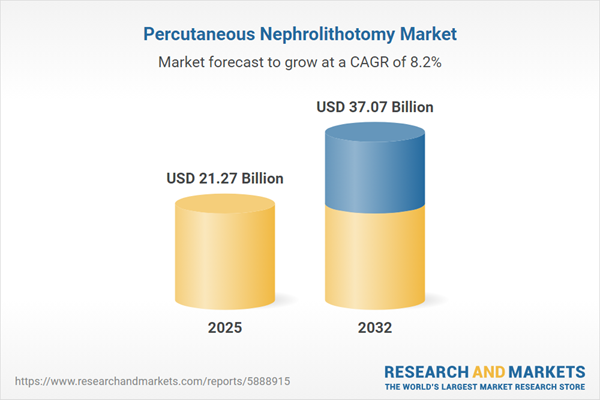Speak directly to the analyst to clarify any post sales queries you may have.
Percutaneous nephrolithotomy is transforming kidney stone management through minimally invasive approaches, enabling healthcare organizations to drive urological workflow improvements and expand their technological capabilities. For senior decision-makers, this report presents focused insights to guide operational strategy and promote efficient, patient-centered care delivery.
Percutaneous Nephrolithotomy Market Snapshot
The global percutaneous nephrolithotomy market reached $19.66 billion in 2024, registering a compound annual growth rate of 8.24%. Market growth is largely propelled by a shift toward less invasive stone-removal procedures and an ongoing advance in medical technology. Device improvements and procedure optimization have fueled modernization throughout the health sector. Stakeholders in both developed and emerging regions recognize these nephrolithotomy solutions as pivotal for enhancing procedural capacity, increasing patient throughput, and maintaining consistent care across varied clinical settings.
Scope & Segmentation
- Product Types: Baskets, dilators, guidewires, sheaths, advanced lithotripters, and nephroscopes support interventions from simple to complex, enabling tailored device selection for every procedural requirement.
- Procedure Types: Micro, mini, standard, and ultra mini procedures are available, each designed to address a specific range of anatomical variations and clinical risk levels, contributing to safer, individualized therapy.
- End Users: Ambulatory surgical centers, private clinics, and public hospitals utilize percutaneous nephrolithotomy to standardize treatment pathways while promoting care quality for diverse patient groups.
- Technologies: Laser, pneumatic, and ultrasonic systems align with institutional needs, providing procurement flexibility and supporting clinical teams to meet both routine and challenging case demands.
- Applications: Devices are employed in common and complex renal stone conditions, allowing for operational adaptation and readiness for specialized care scenarios.
- Patient Types: Solutions are designed for both pediatric and adult populations, ensuring organizations can meet clinical guidelines and serve a complete patient spectrum efficiently.
- Regions: Americas, Europe, Middle East, Africa, and Asia Pacific drive market development, with emphasis on regulatory diversity and local innovation in the United States, Canada, Germany, Japan, and China.
- Leading Companies: Boston Scientific Corporation, KARL STORZ SE & Co. KG, Olympus Corporation, Richard Wolf GmbH, Stryker Corporation, Cook Medical LLC, Teleflex Incorporated, CONMED Corporation, Dornier MedTech GmbH, and Lumenis Ltd. actively influence global market movements and shape solution advances.
Percutaneous Nephrolithotomy: Key Takeaways for Senior Decision-Makers
- Adoption of miniaturized instruments and integration of advanced imaging supports seamless alignment with evolving organizational workflow structures, empowering faster procedural turnaround and care standardization.
- Comprehensive device portfolios allow organizations to remain agile, adjusting to dynamic clinical standards and shifting demographics without operational disruption.
- Ambulatory care centers are positioned to scale services and optimize allocation of staff and materials, enhancing their ability to address fluctuating demand and maintain case efficiency.
- Sustained development in manufacturing and procurement reduce reliance on traditional surgery, helping organizations control spending and access innovative device platforms.
- Inter-organizational collaboration in research and improvements across the supply chain contribute to greater regulatory flexibility and supply reliability for multi-site healthcare entities.
Tariff Impact: Navigating U.S. Device Import Challenges
Recent tariff changes on precision medical devices have elevated procurement costs for U.S. healthcare facilities. In response, leadership teams are recalibrating purchasing frameworks and adjusting budget allocations. Prominent industry players are meeting these shifting conditions by broadening supply chains and expanding domestic manufacturing operations, helping organizations secure ongoing access to essential nephrolithotomy equipment despite regulatory uncertainty and fluctuating expenses.
Methodology & Data Sources
This analysis combines the expertise of clinical leaders and procurement professionals with a systematic review of medical literature and regulatory records. Both qualitative and quantitative approaches underpin an assessment of device usage trends and regional adoption patterns, supporting strategic planning in changing clinical environments.
Why This Report Matters
- Equips executive teams to align new technologies with organizational priorities in contemporary urology care.
- Supports leadership in segmenting markets and navigating a global regulatory landscape to enhance risk management and maintain business continuity.
- Offers evidence-based analytics and actionable guidance for deploying technology effectively across a range of clinical settings.
Conclusion
Percutaneous nephrolithotomy is reshaping kidney stone management with adaptable, effective solutions. Senior leaders can leverage these findings to strengthen operational performance and elevate quality of care system-wide.
Additional Product Information:
- Purchase of this report includes 1 year online access with quarterly updates.
- This report can be updated on request. Please contact our Customer Experience team using the Ask a Question widget on our website.
Table of Contents
3. Executive Summary
4. Market Overview
7. Cumulative Impact of Artificial Intelligence 2025
Companies Mentioned
The companies profiled in this Percutaneous Nephrolithotomy market report include:- Boston Scientific Corporation
- KARL STORZ SE & Co. KG
- Olympus Corporation
- Richard Wolf GmbH
- Stryker Corporation
- Cook Medical LLC
- Teleflex Incorporated
- CONMED Corporation
- Dornier MedTech GmbH
- Lumenis Ltd.
Table Information
| Report Attribute | Details |
|---|---|
| No. of Pages | 197 |
| Published | November 2025 |
| Forecast Period | 2025 - 2032 |
| Estimated Market Value ( USD | $ 21.27 Billion |
| Forecasted Market Value ( USD | $ 37.07 Billion |
| Compound Annual Growth Rate | 8.2% |
| Regions Covered | Global |
| No. of Companies Mentioned | 11 |









